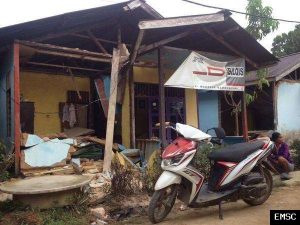
From matchbook-sized sensors plugged into a desktop computer to location-tagged tweets, the earthquake data provided by “citizen seismologists” have grown in size and quality since 2000, according to the field’s researchers.
At a session at the Seismological Society of America’s (SSA) 2016 Annual Meeting April 20-22 in Reno, Nevada, seismologists from around the world will discuss how crowd-sourced information on felt earthquakes is increasingly integrated with data collected by seismometers, to provide a more complete picture of an earthquake event and its impacts.
“As researchers, we gain incredibly large amounts of data at very little cost from citizen seismology,” says Michelle Guy, a computer scientist at the U.S. Geological Survey. “But we also gain a new kind of data, since people are much more impact-oriented when it comes to earthquakes. We learn what people saw, what they felt, and what they went through as they experienced these seismic events.”
People have been reporting on the earthquakes they feel through dedicated websites such as the USGS’ Did You Feel It site since 2000, and online reporting of earthquakes has proliferated through social media sites such as Twitter and Facebook and through mobile phone apps such as LastQuake from the European Mediterranean Seismic Center (EMSC).
And in a way, says EMSC Secretary General Rémy Bossu, citizen seismology stretches back even further into the past, since personal, eyewitness reports provided most earthquake data before the development of modern seismic monitoring networks. “Thanks to Internet technologies, it is now easy to integrate human reports and they are fully complementary with what the seismic network provides: the latter provides information on the event, a hazard type of information, and the other provides information on its effects, or risk information.”
Even in places like Japan, a country densely covered with more than 5000 strong-motion seismic stations, seismologists are turning to a citizen-based seismic network to help refine their reports of real-time damage estimates, according SSA speaker Shohei Naito, a researcher at Japan’s National Research Institute for Earth Science and Disaster Prevention. Through apps installed on devices that contain acceleration sensors, such as some mobile phones and iPads, people transmit their shaking data to be combined with others into a larger seismic intensity map during an earthquake. The citizen-generated data can improve the accuracy and speed of damage estimates, Naito says.
Similar data are collected by CalTech’s Quake Catcher Network, using both embedded sensors in mobile devices, laptops and tablets as well as plug-in devices for desktop computers. Since 2008, these sensors installed everywhere from schools to homes have collected thousands of earthquake records, says SSA presenter Danielle Sumy of the Incorporated Research Institutions for Seismology (IRIS).
Since 2009, the U.S. Geological Survey has been crowd-sourcing tweets to locate and assess earthquakes worldwide, says Guy. The Twitter system can often detect small earthquakes before seismic instruments do in places around the world where seismometer coverage is sparse—sometimes within 20 seconds of an earthquake.
Earthquake data gleaned from social media come with a special set of challenges, she acknowledges. For instance, it can be difficult to connect a tweet with a specific location, although this is slowly changing with the advent of more GPS-tagged data posted from mobile phones. Originally only 3 to 5% of earthquake tweets were GPS-located, but that has grown to 15%, Guy said.
“We only hear about the earthquakes that people feel, so this is limited to a small subset of earthquakes that people actually feel,” she noted. “In no way does this do away with the need for more traditional instrumentation.”
Guy and Bossu suggest that one of the most exciting aspects of citizen seismology is the new window it opens on the aftermath or the impacts of earthquakes, especially when it comes to the impacts on infrastructure such as roads and buildings. “That’s one of the things that’s being tapped into with groups such FEMA,” says Guy, “to help them organize how they might respond to an earthquake, based on what people are experiencing and whether there are reports of fires, or damage to infrastructure.”
After the 2015 Gorkha earthquake in Nepal, Bossu and his colleagues surveyed LastQuake users in the region—downloads of the app went viral after the quake—and found that half of the users surveyed would also like more information from the app about what to do after strong shaking. He said LastQuake is being revised to deliver more “do’s and don’ts” after an earthquake.
Note: The above post is reprinted from materials provided by Seismological Society of America.










